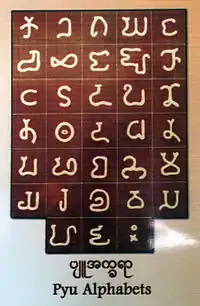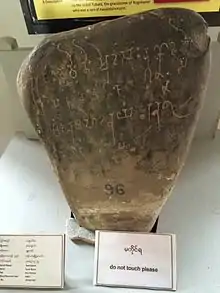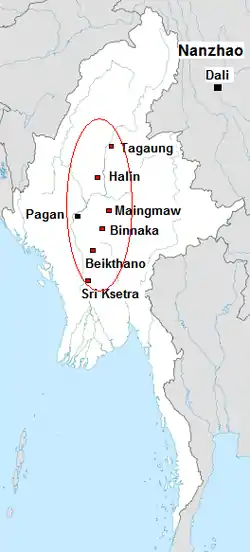Pyu language (Sino-Tibetan)
The Pyu language (Burmese: ပျူ ဘာသာ, IPA: [pjù bàðà]; also Tircul language) is an extinct Sino-Tibetan language that was mainly spoken in what is now Myanmar in the first millennium CE. It was the vernacular of the Pyu city-states, which thrived between the second century BCE and the ninth century CE. Its usage declined starting in the late ninth century when the Bamar people of Nanzhao began to overtake the Pyu city-states. The language was still in use, at least in royal inscriptions of the Pagan Kingdom if not in popular vernacular, until the late twelfth century. It became extinct in the thirteenth century, completing the rise of the Burmese language, the language of the Pagan Kingdom, in Upper Burma, the former Pyu realm.[1]
| Pyu | |
|---|---|
 Pyu alphabets | |
| Region | Pyu city-states, Pagan Kingdom |
| Extinct | 13th century |
Sino-Tibetan
| |
| Pyu script | |
| Language codes | |
| ISO 639-3 | pyx |
pyx | |
| Glottolog | burm1262 |
The language is principally known from inscriptions on four stone urns (7th and 8th centuries) found near the Payagyi pagoda (in the modern Bago Township) and the multi-lingual Myazedi inscription (early 12th century).[2][3] These were first deciphered by Charles Otto Blagden in the early 1910s.[3]
The Pyu script was a Brahmic script. The most recent scholarship suggests the Pyu script may have been the source of the Burmese script.[4]
Classification


The Pyu language was a Sino-Tibetan language related to Old Burmese,[5] although the degree of proximity is debated. The language is tentatively classified within the Lolo-Burmese languages by Matisoff and thought to most likely be Luish by Bradley. Van Driem feels it is best treated as an independent branch of Sino-Tibetan pending further evidence.[6]
Usage
The language was the vernacular of the Pyu states. But Sanskrit and Pali appeared to have co-existed alongside Pyu as the court language. The Chinese records state that the 35 musicians that accompanied the Pyu embassy to the Tang court in 800–802 played music and sang in the Fàn (梵 "Sanskrit") language.[7]
List of Pyu inscriptions
| Location | Inventory number |
|---|---|
| Halin | 01[8] |
| Śrī Kṣetra | 04[9] |
| Pagan | 07[10] |
| Pagan | 08[11] |
| Śrī Kṣetra | 10[12] |
| Pagan | 11[13] |
| Śrī Kṣetra | 12[14] |
| Śrī Kṣetra | 22[15] |
| Śrī Kṣetra | 25[16] |
| Śrī Kṣetra | 28[17] |
| Śrī Kṣetra | 29[18] |
| Myittha | 32[19] |
| Myittha | 39[20] |
| Śrī Kṣetra | 42[21] |
| Śrī Kṣetra | 55[22] |
| Śrī Kṣetra | 56[23] |
| Śrī Kṣetra | 57[24] |
| Halin | 60[25] |
| Halin | 61[26] |
| ??? | 63[27] |
| Śrī Kṣetra | 105[28] |
| Śrī Kṣetra | 160[29] |
| ??? | 163[30] |
| Śrī Kṣetra | 164[31] |
| Śrī Kṣetra | 167[32] |
Vocabulary
Below are selected Pyu basic vocabulary items from Gordon Luce (1985: 66-69)[33] and Marc Miyake (2016).[34]
| Gloss | Luce (1985) | Miyake (2016) |
|---|---|---|
| one | tå | ta(k·)ṁ |
| two | hni° | kni |
| three | ho:, hau: | hoḥ |
| four | pḷå | plaṁ |
| five | pi°ŋa | (piṁ/miṁ) ṅa |
| six | tru | tru(k·?) |
| seven | kni | hni(t·?)ṁ |
| eight | hrå | hra(t·)ṁ |
| nine | tko | tko |
| ten | sū, sau | su |
| twenty | tpū | |
| bone, relic | ru | |
| water | tdu̱- | |
| gold | tha | |
| day | phru̱ | |
| month | de [ḷe ?] | |
| year | sni: | |
| village | o | |
| good; well | ha | |
| to be in pain, ill | hni°: | |
| nearness | mtu | |
| name | mi | |
| I | ga°: | |
| my | gi | |
| wife | maya: | |
| consort, wife | [u] vo̱: | |
| child, son | sa: | |
| grandchild | pli, pli° |
Notes
- Htin Aung, pp. 51–52
- Blagden, C. Otto (1913–14). "The 'Pyu' inscriptions". Epigraphia Indica. 12: 127–132.
- Beckwith, Christopher I. (2002). "A glossary of Pyu". In Beckwith, Christopher I. (ed.). Medieval Tibeto-Burman languages. Brill. pp. 159–161. ISBN 978-90-04-12424-0.
- Aung-Thwin, pp. 167–177
- Language List, PYX
- van Driem, George. "Trans-Himalayan Database". Retrieved 7 November 2012.
- Aung-Thwin, pp. 35–36
- Miles, James. (2016). Documentation of a Pyu inscription (PYU001) held at the Archaeological Museum at Halin [Data set]. Zenodo. doi:10.5281/zenodo.579711
- Miles, James. (2016). Documentation of a Pyu inscription (PYU004) around a funerary urn held by the Śrī Kṣetra museum [Data set]. Zenodo. doi:10.5281/zenodo.581381
- Miles, James. (2016). Documentation of the quadrilingual Pyu inscription (PYU007) kept in an inscription shed on the grounds of the Myazedi pagoda in Pagan [Data set]. Zenodo. doi:10.5281/zenodo.579873
- Miles, James. (2016). Documentation of the quadrilingual Pyu inscription (PYU008) held at the Pagan museum, originally found in the grounds of the Myazedi pagoda [Data set]. Zenodo. doi:10.5281/10.5281/zenodo.580158
- Miles, James. (2016). Documentation of a Pyu inscription (PYU010) kept in one of two inscription sheds on the grounds of the Śrī Kṣetra museum [Data set]. Zenodo. doi:10.5281/zenodo.580597
- Miles, James. (2016). Documentation of a bilingual Pyu inscription (PYU011) held at the Pagan museum [Data set]. Zenodo. doi:10.5281/zenodo.580282
- Miles, James. (2016). Documentation of a Sanskrit-Pyu bilingual inscription (PYU012) around the base of a Buddha statue held by the Śrī Kṣetra museum [Data set]. Zenodo. doi:10.5281/zenodo.581383
- Miles, James. (2016). Documentation of a Pyu inscription (PYU022) held by the Śrī Kṣetra museum [Data set]. Zenodo. doi:10.5281/zenodo.581468
- Miles, James. (2016). Documentation of a Pyu inscription (PYU025) on the base of a funerary urn held at the Śrī Kṣetra museum [Data set]. Zenodo. doi:10.5281/zenodo.580777
- Miles, James. (2016). Documentation of a Pyu inscription (PYU028) kept in one of two inscription sheds on the grounds of the Śrī Kṣetra museum [Data set]. Zenodo. doi:10.5281/zenodo.580791
- Miles, James. (2016). Documentation of a Pyu inscription (PYU029) kept in one of two inscription sheds on the grounds of the Śrī Kṣetra museum [Data set]. Zenodo. doi:10.5281/zenodo.581217
- Miles, James, & Hill, Nathan W. (2016). Documentation of a Pyu inscriptions (PYU032) kept in an inscription shed on the grounds of a pagoda in Myittha [Data set]. Zenodo. doi:10.5281/zenodo.579848
- Miles, James. (2016). Documentation of a Pyu inscription (PYU039) kept in an inscription shed on the grounds of a monastery in Myittha [Data set]. Zenodo. doi:10.5281/zenodo.579725
- Miles, James. (2016). Documentation of a Pyu inscription (PYU042) kept in one of two inscription sheds on the grounds of the Śrī Kṣetra museum [Data set]. . Zenodo. doi:10.5281/zenodo.581251
- Miles, James. (2016). Documentation of a Pyu inscription (PYU055) held by the Śrī Kṣetra museum [Data set]. Zenodo. doi:10.5281/zenodo.806133
- Miles, James. (2016). Documentation of a Pyu inscription (PYU056) held by the Śrī Kṣetra museum [Data set]. Zenodo. doi:10.5281/zenodo.806148
- Miles, James. (2016). Documentation of a Pyu inscription (PYU057) held by the Śrī Kṣetra museum [Data set]. Zenodo. doi:10.5281/zenodo.806163
- Miles, James. (2016). Documentation of a Pyu inscriptions (PYU060) kept in the inscription shed outside the Archaeological Museum at Halin [Data set]. Zenodo. doi:10.5281/zenodo.579695
- Miles, James. (2016). Documentation of a Pyu inscriptions (PYU061) held at the Archaeological Museum at Halin [Data set]. Zenodo. doi:10.5281/zenodo.579710
- Miles, James. (2016). Documentation of a Pyu inscription (PYU063) held at the National Museum (Burmese: အမျိုးသား ပြတိုက်) in Rangoon [Data set]. Zenodo. http://doi.org/ doi:10.5281/zenodo.806174
- Miles, James. (2016). Documentation of a Pyu inscription on a gold ring (PYU105) held by the Śrī Kṣetra museum [Data set]. Zenodo. doi:10.5281/zenodo.806168
- Miles, James. (2016). Documentation of a Pyu inscription (PYU160) discovered in Śrī Kṣetra [Data set]. Zenodo. doi:10.5281/zenodo.823725
- Miles, James. (2016). Documentation of a Pyu inscription (PYU163) [Data set]. Zenodo. doi:10.5281/zenodo.825673
- Miles, James. (2016). Documentation of a Pyu inscription (PYU164) [Data set]. Zenodo. doi:10.5281/zenodo.825685
- Miles, James. (2016). Documentation of a Pyu inscription (PYU167) [Data set]. Zenodo. doi:10.5281/zenodo.823753
- Luce, George. 1985. Phases of Pre-Pagan Burma: languages and history (volume 2). Oxford University Press. ISBN 0-19-713595-1
- Miyake, Marc. 2016. Pyu numerals in comparative perspective. Presentation given at SEALS 26.
References
- Aung-Thwin, Michael (2005). The mists of Rāmañña: The Legend that was Lower Burma (illustrated ed.). Honolulu: University of Hawai'i Press. ISBN 978-0-8248-2886-8.
- Harvey, G. E. (1925). History of Burma: From the Earliest Times to 10 March 1824. London: Frank Cass & Co. Ltd.
- Htin Aung, Maung (1967). A History of Burma. New York and London: Cambridge University Press.
Further reading
- Blagden, C. Otto (1911). "A preliminary study of the fourth text of the Myazedi inscriptions". Journal of the Royal Asiatic Society of Great Britain & Ireland. 43 (2): 365–388. doi:10.1017/S0035869X00041526.
- Griffiths, Arlo; Hudson, Bob; Miyake, Marc; Wheatley, Julian K. (2017). "Studies in Pyu Epigraphy, I: State of the Field, Edition and Analysis of the Kan Wet Khaung Mound Inscription, and Inventory of the Corpus". Bulletin de l'École française d'Extrême-Orient. 103: 43–205. doi:10.3406/befeo.2017.6247.
- Shafer, Robert (1943). "Further analysis of the Pyu inscriptions". Harvard Journal of Asiatic Studies. 7 (4): 313–366. doi:10.2307/2717831. JSTOR 2717831.
- Miyake, Marc (2018). "Studies in Pyu Phonology, ii: Rhymes". Bulletin of Chinese Linguistics. 11 (1–2): 37–76. doi:10.1163/2405478X-01101008.
- Miyake, Marc (2019). "A first look at Pyu grammar". Linguistics of the Tibeto-Burman Area. 42 (2): 150–221. doi:10.1075/ltba.18013.miy.
External links
- Searchable corpus of Pyu inscriptions
- Datasets for Pyu inscriptions, photographed by James Miles